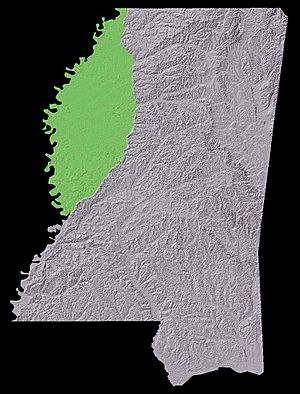Education segregation in the Mississippi Delta facts for kids
The Mississippi Delta region had schools that were kept separate for Black and white students for a very long time. This is called segregated schools. Even in the 2016–2017 school year, East Side High School in Cleveland, Mississippi, had almost all Black students. Out of 360 students, 359 were African-American.
The Mississippi Delta is a special area in the northwest part of Mississippi. It has nineteen counties and is bordered by the Mississippi River and the Yazoo River. This region is one of the poorest parts of the United States.
Contents
Why Schools Were Segregated
The Delta region has always had many African-American residents. For example, Sunflower County has been about 72% Black for many years. In the 1960s, many African Americans in Sunflower County earned very little money. It was often below the federal poverty line.
Jobs were hard to find because machines took over farm work. Because of this, many people moved away from the Delta. They went to bigger cities in the North and West. The population in the Delta has been getting smaller since the 1930s. In 1962, a civil rights worker said Sunflower County was "the worst county in the worst state" for treating people unfairly because of their race.
The towns in the Delta are small. Cleveland, Mississippi, for example, has about 12,000 people. This is barely enough for one high school. But for many years, it had two separate high schools. The Delta region was very determined to keep its schools segregated.
The Brown v. Board of Education Decision
In 1954, a very important court case called Brown v. Board of Education said that separate schools for Black and white students were against the law. This decision changed education rules for the whole country. However, many places in the Delta did not follow this rule right away. They waited until the 1960s to make changes.
After Brown, some groups like the Citizens' Councils were formed. They wanted to keep schools segregated. They even helped start private schools called "segregation academies" for white children. In Cleveland, Mississippi, they tried a "freedom of choice" plan in 1966. This plan let students choose which school to attend. But it often meant schools stayed segregated.
Before Brown, public schools for African-American children in the Delta were not always free. And going to school was not always required. Many Black children did not attend school. In Sunflower County, for example, many Black children worked in farming. They often helped with the cotton harvest in October and November.
Also, schools were sometimes too far away to walk to. School boards did not always provide buses for Black students. Money was also a big problem. In 1949–1950, Sunflower County spent the same amount of money on white students (who were 28% of the population) as it did on Black students (who were 72%). Black families were sometimes asked to pay money to heat their schoolhouses. For many Black children in the Delta, Brown was not just about going to school with white kids. It was about being able to go to school at all.
Segregation After the Court Order
After the Brown decision, Mississippi did not do much at first. They waited for courts to force them to change. Other states, like Virginia, started making changes and opening private schools earlier. Mississippi's private "segregation academies" did not start opening until 1967.
In 1969, a court said that Mississippi's money grants for private schools (which were mostly segregation academies) were illegal. Later that year, another court case said Mississippi's "freedom of choice" plan was not fair.
Across the Delta, many white parents started private schools for their children. Public school districts sometimes even gave away school buildings to these new private schools. This helped keep schools separate.
Sunflower County Example
Sunflower County is a good example of what happened. Its population had shrunk a lot by 1970. Around 1968, the school district sold Inverness High School to a private school called Central Delta Academy. There were two other all-white private schools in the county: Indianola Academy and North Sunflower Academy.
These private schools took many white children away from the public schools. This made the public schools mostly Black. For example, the Sunflower County School District became about 80% Black and 20% white. The private schools also tried to hire teachers away from the public schools.
To prevent white students in public schools from mixing with Black students, things like proms and dances were sometimes canceled. This was very unfair to all students. Over time, the state combined some school districts, like Sunflower, Drew, and Indianola, to try and fix these problems.
Schools Today
Even today, some schools in the Delta region are still mostly one race. For example, in the 2014–2015 school year, Coahoma Agricultural High School had 267 Black students, 1 Hispanic student, and no white students.
In Bolivar County, lawyers argued for 51 years about keeping Cleveland's two high schools separate. Cleveland High School used to be for white students. By 2015, it was about half Black and half white. This school was seen as a success. But the town's other high school, East Side, had 360 students in 2015, and 359 of them were Black.
Finally, in September 2017, the town had to follow a federal court order. They combined the two high schools into one: Cleveland Central High School.
Just three miles away from Cleveland, there is a private school called Bayou Academy. It was started in 1964. In the 2015–2016 school year, out of 355 students, only 4 were Black. This shows that many private schools in the area are still mostly white.
In Humphreys County, Humphreys Academy had only one Black student out of 156 students in 2015–2016. These examples show how the history of segregation still affects schools in the Mississippi Delta today.


